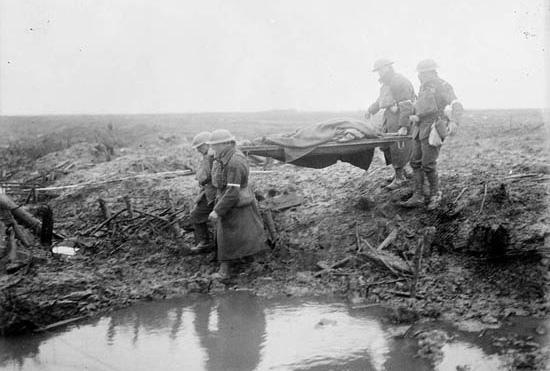No Man’s Land
First World War Audio Archive
No Man’s Land
Transcript
Hill 62 Memorial Belgium.
it hadn’t been for that little old snowstorm... it was the best barrage that we ever had. The snowstorm kept those Fritzy’sCourtrai Memorial Belgium.
head down and they couldn’t see us coming and we just went over there and captured the Vimy Ridge, for the second time.Le Quesnel Memorial Belgium.
The Canadians had taken it once before and the Australians were put in to hold the Ridge after it had been taken and,Gueudecourt Memorial France.
by gosh, the Germans counterattacked on the Australians and took it back. So we had to take it twice. And from Vimy Ridge, we just kept on going and going until we came to what we calledDury Memorial France.
the chalk pits and there we stayed. No man’s land was eight yardsMonchy Memorial France.
apart. That was something. When we were in the chalk pits, the Germans were shooting those, what we called Jack Johnsons at us. Jack Johnsons, big black shells that took, made a bigPasschendaele Memorial Belgium.
black smoke and blew things all to pieces. Well, a piece of shrapnel come over and just happened to hit me just on the top ofMasnières memorial France.
my left shoulder and I put my hand in under my tunic and under my shirt and I said, “I’m hit!” And Eddie Thompson said, “Oh, you’re not going to leave me, you’re not going to leave me!”Bourion Wood Memorial France.
And I said, “I’m not going to leave ya.” I just took this thing, piece of shrapnel out and threw it away and stayed there. I was too scared to move. I didn’t wanna, I was sitting in thatCourcelette Memorial France.
funk hole, I might as well stay there. That’s the safest place that I know. No use of running back and getting hit with a big shell. So, that was it. Then we moved on after a while up intoBeaumont-Hamel Memorial France.
the, into the Arras country. And after those years fighting withSt. Julien Memorial Belgium.
this one and fighting with that one, casualties all over, good friends, good fellows, Shorty McNabb, Merle Kennedy, and some more, and some more.Canadian National Vimy Memorial France.
They all disappeared or got wounded, sent back.Description
Mr. Smith describes the retaking of Vimy Ridge, and being wounded by shrapnel after reaching the Chalk Pit.
Allan A ‘Spike’ Smith
Allan A ‘Spike’ Smith was born in Minto, Manitoba on May 7, 1894. Mr. Smith enlisted while attending the University of Saskatchewan, joining the 196th Battalion. He did his basic training at Camp Hughes, Manitoba. Once overseas, he was at Camp Seaford in England when he was selected to reinforce the 46th Battalion. He saw his first action just prior to Vimy, and was wounded by shrapnel at the Chalk Pits. He returned to action at Drocourt-Queant, and was again wounded by shrapnel. He later returned to Passchendaele. He received a Military Medal for bravery. After the war, Mr. Smith became a farmer, coached a women’s volleyball team, and became an agriculture inspector. He died on August 12, 1981.
Meta Data
- Medium:
- Video
- Owner:
- Veterans Affairs Canada
- Duration:
- 2:08
- Person Interviewed:
- Allan A ‘Spike’ Smith
- War, Conflict or Mission:
- First World War
- Location/Theatre:
- Europe
- Battle/Campaign:
- Vimy
- Branch:
- Army
- Units/Ship:
- 196th Battalion
- Rank:
- Lance-Corporal
- Occupation:
- Infantryman
Attestation
Related Videos
- Date modified:




